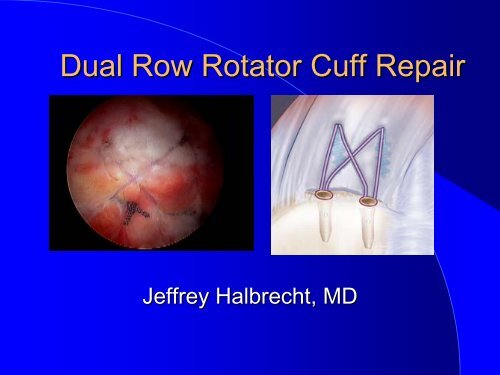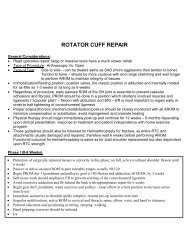You also want an ePaper? Increase the reach of your titles
YUMPU automatically turns print PDFs into web optimized ePapers that Google loves.
<strong>Dual</strong> <strong>Row</strong> <strong>Rotator</strong> <strong>Cuff</strong> <strong>Repair</strong><br />
Jeffrey Halbrecht, , MD
Why <strong>Dual</strong> <strong>Row</strong>?<br />
• Poor structural integrity on<br />
f/u studies of single row<br />
repair<br />
• Restore anatomy ( footprint)<br />
• Stronger <strong>Repair</strong> ?<br />
• Faster rehab ?<br />
• Better results ?
Advantages of <strong>Dual</strong> <strong>Row</strong><br />
• Restore foot print<br />
• Minimize pop motion at<br />
repair site<br />
• Limit synovial fluid<br />
migration into repair site<br />
• Extended healing<br />
surface<br />
• Improved<br />
biomechanical strength<br />
with multiple points of<br />
fixation
<strong>Dual</strong> <strong>Row</strong> Options<br />
• Technique<br />
– Two separate rows<br />
– Suture spanning<br />
(suture bridge)
High Rate of “Recurrent Tears”<br />
after RTC <strong>Repair</strong><br />
• Harryman D: JBJS 1991<br />
• Liu S: Arthroscopy 1994<br />
• Gerber C: JBJS 2000<br />
20-80%<br />
residual defects<br />
• Boileau P: ICSS 2004<br />
• Galatz L: JBJS 2004<br />
• Bishop J: AAOS/AOSSM Specialty Day 2004
Footprint: Summary<br />
• Normal Approximately<br />
12-15mm<br />
15mm<br />
– Nottage<br />
Nottage Arthroscopy 2004<br />
• Single <strong>Row</strong><br />
– 5-66 mm
Review literature on <strong>Dual</strong> <strong>Row</strong>:<br />
• Biomechanical<br />
– Tensile strength<br />
– Gap formation<br />
– Motion at repair site<br />
– Contact surface<br />
– Contact pressure<br />
• Clinical results<br />
• <strong>Cuff</strong> integrity on f/u imaging
Meier: <strong>Dual</strong> <strong>Row</strong> Stronger to Cyclic<br />
Loading<br />
2 row > TOS > single row<br />
• (TOS) failure<br />
• (SRSA) failure<br />
• (DRSA)<br />
75.3 cycles<br />
798.3 cycles<br />
had no failures<br />
5000 cycles : failure = 10mm or greater<br />
Meier SW, Meier JD.<br />
The effect of double-row fixation on initial repair strength in rotator cuff repair: a biomechanical study.<br />
Arthroscopy. 2006 Nov;22(11):1168-73
Ma : Higher Ultimate Tensile<br />
Load<br />
• Double <strong>Row</strong> mean UTL 287 ±<br />
24 N<br />
• 3 single-row repairs tested<br />
– simple suture 191 N;<br />
– MMA<br />
– massive cuff<br />
212 N<br />
250 N (P < .05).<br />
Ma CB, Comerford L, Wilson J, Puttlitz CM. Biomechanical evaluation of arthroscopic<br />
rotator cuff repairs: Double-row compared with single-row fixation. J Bone Joint<br />
Surg Am. . 2006;88<br />
88:403–410.<br />
410.<br />
.
In vivo studies of UTL in a goat<br />
rotator cuff model showed no<br />
significant biomechanical<br />
differences between single-row<br />
and double-row repairs at 4 and<br />
8 weeks<br />
• Fealy S, Rodeo SA, MacGillivray JD, Nixon AJ, Adler RS, Warren RF.<br />
Biomechanical evaluation of the relation between number of<br />
suture anchors and strength of the bone-tendon interface in a<br />
goat rotator cuff model. Arthroscopy. . 2006;22<br />
22:595–602
Kim: Less Gap Formation<br />
Higher Ultimate Tensile Load<br />
• Less gap formation with<br />
cyclic loading with 2 row<br />
repair (p
Meier S: Restores Footprint<br />
• <strong>Dual</strong> row restores 100%<br />
footprint<br />
• TOS restores 71 %<br />
• Single row restores 46%<br />
Medial<br />
Lateral<br />
S Meier : <strong>Rotator</strong> cuff repair: the effect of double-row fixation on threedimensional<br />
repair site.<br />
J Shoulder Elbow Surg. 2006 Nov-Dec;15(6):691-6
Park: Improved Ultimate Load<br />
with Suture Bridge<br />
• Tranosseous equivalent (suture bridge)<br />
– 443.0 +/- 87.8 N<br />
• double-row technique<br />
– 299.2 +/- 52.5 N (P = .043).<br />
• Gap formation the same…<br />
• 30 cycles (10-180 180 N) then pullout<br />
• Used interference screw laterally<br />
J Shoulder Elbow Surg. 2007 Feb 21; [Epub[<br />
ahead of print]<br />
Part II: Biomechanical assessment for a footprint-restoring<br />
restoring<br />
transosseous-equivalent equivalent rotator cuff repair technique compared with a<br />
double-row repair technique.<br />
Park MC, Tibone JE, Elattrache NS, Ahmad CS, Jun BJ, Lee TQ.
Park: Improved Contact Pressure<br />
and Contact Area with Suture Bridge<br />
• Increased contact area and contact<br />
pressure with 4 suture bridge technique<br />
• Contact area<br />
– 4 suture bridge ( criss –cross)<br />
124 mm<br />
– 2 row (separate) 63.3<br />
• Contact Pressure<br />
63.3 (p< .05)<br />
– 4 suture bridge .27 Mpa<br />
– 2 row .19 M (p=.002)<br />
Park MC, Elattrache NS, Tibone JE, Ahmad CS, Jun BJ, Lee TQ. Part I:<br />
Footprint contact characteristics for a transosseous-equivalent equivalent rotator cuff repair<br />
technique compared with a double-row technique.<br />
J Shoulder Elbow Surg. . 2007 Feb 21
Meier SW: Less Motion at <strong>Repair</strong><br />
Site (submitted)
Sugaya: : Improved <strong>Cuff</strong> Integrity<br />
• 86 pts<br />
• 31 months<br />
• 2 row<br />
• 83 % intact on fu<br />
MRI<br />
– 5% small- medium<br />
– 40% large- massive<br />
Sugaya H, Maeda K, Matsuki K, Moriishi J.<br />
<strong>Repair</strong> integrity and functional outcome after arthroscopic double-row rotator cuff repair. A<br />
prospective outcome study.<br />
J Bone Joint Surg Am. 2007 May;89(5):953-60
Huijsman: : Ultra Sound Follow up<br />
• Good strength and ROM..<br />
• Good integrity by US 83%<br />
overall<br />
Huijsmans PE, Pritchard MP, Berghs BM, van Rooyen KS, Wallace AL, de Beer JF.<br />
Arthroscopic rotator cuff repair with double-row fixation.<br />
J Bone Joint Surg Am. 2007 Jun;89(6):1248-57
Anderson: Excellent Clinical<br />
Results Low Re-tear Rate<br />
• 52 shoulders<br />
• 2 separate rows of<br />
suture anchors<br />
• Fu min 2 years<br />
• Exc clinical results<br />
• 17 % retear on f/u<br />
U/S<br />
Anderson K, Boothby M, Aschenbrener D, van Holsbeeck M Outcome and structural<br />
integrity after arthroscopic rotator cuff repair using 2 rows of fixation: Minimum 2-2<br />
year follow-up<br />
up. Am J Sports Med. . 2006;34<br />
34:1899–1905.<br />
1905.
Rate of intact RC repairs at final follow-up:<br />
<strong>Dual</strong>-row<br />
Single-row<br />
Pre-op<br />
tear size:<br />
Huijmans<br />
et al.<br />
(US)<br />
Sugaya<br />
et al.<br />
(MRI)<br />
Liu<br />
et al.<br />
(Arthrogm)<br />
Bishop<br />
et al.<br />
(MRI)<br />
Harryman<br />
et al.<br />
(US)<br />
Galatz<br />
et al.<br />
(US)<br />
Small<br />
Medium<br />
~91%<br />
95%<br />
80% 80%<br />
80%<br />
Large<br />
Massive<br />
~63%<br />
60%<br />
30%<br />
18% ~48% 6%<br />
Submitted<br />
for pub.<br />
AANA<br />
2004<br />
Arthroscopy<br />
1994<br />
AAOS<br />
2004<br />
JBJS<br />
1991<br />
JBJS<br />
2004
Summary of Literature<br />
• <strong>Dual</strong> row restores better footprint (100%)<br />
• <strong>Dual</strong> <strong>Row</strong> Stronger<br />
– ultimate tensile load, cyclic loading<br />
• Less gap formation<br />
– Cyclic loading<br />
• Suture bridge better than two separate rows.<br />
– Ultimate Load, contact pressure, contact area<br />
• Increased contact pressure and contact area<br />
• Better structural integrity on post op imaging
Criticisms of <strong>Dual</strong>-<strong>Row</strong> <strong>Repair</strong>:<br />
– Potential for over-tensioning.<br />
– Increased surgical time.<br />
– Increased technical difficulty<br />
– Increase cost.<br />
– Multiple prominent suture knots.
The Answer:<br />
Suture Spanning DR Technique<br />
with Versalok
Suture-Spanning Spanning DR <strong>Repair</strong>:<br />
Surgical Time<br />
Meier et al. – Submitted for publication 2007<br />
-30 patients<br />
(15 SSDR/ 15 Standard DR)<br />
SSDR ~20 minutes faster (p
<strong>Dual</strong> <strong>Row</strong> Suture Spanning<br />
• Multiple knots<br />
– Knotless anchors<br />
• Surgical Time<br />
– 20 minutes faster ( p
Low profile<br />
Prominent knots eliminated…
The Versalok:<br />
<strong>Dual</strong> <strong>Row</strong> Suture Spanning<br />
Advantages<br />
• Arthroscopic<br />
• Knotless<br />
• Secure fixation<br />
• Simple technique<br />
• Nothing protruding into SA space<br />
• Allow tensioning of repair<br />
• Versatile technique<br />
• Fast (save $-$<br />
OR time)<br />
• Accurate tensioning<br />
• Versatile
Titanium core<br />
Self locking<br />
anchor:<br />
Locks suture within<br />
anchor after<br />
deployment<br />
PEAK Shell<br />
Pre-deployment<br />
Post-deployment
Versalok: : Deployment<br />
Expanding anchor locks sutures and fixes anchor to bone…<br />
1. Tap<br />
inserter to laser<br />
line.<br />
2. Tension<br />
<strong>Rotator</strong> <strong>Cuff</strong><br />
w/tension<br />
wheel or<br />
manually<br />
3. Deploy<br />
Anchor<br />
Lock suture<br />
by fully squeezing<br />
trigger<br />
4. Unscrew<br />
& Remove anchor shaft by<br />
turning inserter counterclockwise.<br />
Protect sutures<br />
Sub-cortical<br />
fixation<br />
Ø6.3mm<br />
(Post-Deployed OD)<br />
Ø4.9mm<br />
(Pre-Deployed OD)
The Versalok: : Tensioning Gun<br />
Tensioning wheel
• Benefit:<br />
– Maximizes compression onto<br />
tuberosity<br />
– increasing fixation footprint<br />
– Decreased movement of cuff-<br />
bone interface during healing<br />
– Minimize synovial fluid infiltration<br />
• Technique<br />
– Medial row:<br />
• Versalok: : knotless mattress<br />
• Spiralok: : standard mattress<br />
– Lateral row:<br />
• Suture spanning<br />
• Separate row<br />
<strong>Dual</strong> <strong>Row</strong>
<strong>Dual</strong> <strong>Row</strong>:<br />
Crossover : Suture Spanning Technique<br />
One double<br />
loaded medial<br />
anchor<br />
Two Double loaded<br />
medial anchors<br />
Single large<br />
medial matress<br />
Cross for<br />
footprint<br />
compression<br />
Tie Two medial<br />
mattress<br />
Criss-Cross for<br />
footprint<br />
compression<br />
Single cross<br />
Criss-cross
<strong>Dual</strong> <strong>Row</strong>:<br />
Criss- Cross
<strong>Dual</strong> <strong>Row</strong> :<br />
Criss- Cross<br />
Medial <strong>Row</strong> anchors- double loaded<br />
Shuttle sutures through tissue
<strong>Dual</strong> <strong>Row</strong>:<br />
Criss Cross –cont.<br />
Repeat Two Anchors
<strong>Dual</strong> <strong>Row</strong>:<br />
Criss Cross- cont.
<strong>Dual</strong> <strong>Row</strong>:<br />
Criss Cross -cont
<strong>Dual</strong> <strong>Row</strong>:<br />
Criss Cross cont.
<strong>Dual</strong> <strong>Row</strong>:<br />
Criss –Cross- cont.
<strong>Dual</strong> <strong>Row</strong>: Criss Cross
Delamination<br />
Superior (bursal)<br />
layer<br />
Inferior (articular)<br />
layer
Delamination
Consider anatomic footprint reconstruction<br />
for …<br />
delamination<br />
<strong>Dual</strong>-row,<br />
“dual-layer” fixation<br />
Medial row<br />
Lateral row<br />
Slide courtesy of Hiroyuki Sugaya, , MD
<strong>Repair</strong> Scenarios<br />
Delaminated tear<br />
Superficial Deep layer layer<br />
to lateral medial row row<br />
<strong>Dual</strong>-row,<br />
dual-layer fixation
“Anatomic <strong>Repair</strong> of Delaminated <strong>Rotator</strong> <strong>Cuff</strong> Tears-<br />
<strong>Dual</strong>-<strong>Row</strong>/<strong>Dual</strong><br />
<strong>Row</strong>/<strong>Dual</strong>-Layer Fixation”<br />
Meier et. al. – Submitted for publication 2007<br />
~18 N<br />
~18 N
RTCT - Delamination<br />
<strong>Dual</strong>-<strong>Row</strong>/<br />
<strong>Dual</strong>-Layer
Avoid overtensioning. Do not fully lateralize tendon!<br />
Incomplete coverage with DR can still more than with SR technique…
<strong>Rotator</strong> Most common cuff surgery<br />
RTCR<br />
high complication complication<br />
<br />
rate.<br />
failure<br />
of<br />
repair<br />
Supraspinatus<br />
Suture anchor repair<br />
Harryman, , JBJS 1991. Mansat, Orthop Clin North Am, 1997. Liu,<br />
Arthroscopy, 1994. Gazielly, Clin Orth, , 1994. Goutallier, Clin Orthop
<strong>Rotator</strong> <strong>Cuff</strong> <strong>Repair</strong> - Improving Results<br />
Biology<br />
Surgical<br />
Technique &<br />
Fixation<br />
Post-op Stresses<br />
(Rehab.)
– Anatomic restoration<br />
• Recognize tear pattern and accurately re-<br />
approximate tear.<br />
• Restore musculotendinous length-tension<br />
tension<br />
orientation.<br />
• Address delamination.<br />
An • anatomic Restore footprint repair is aanatomically.<br />
An anatomic repair is a LOW TENSION REPAIR









